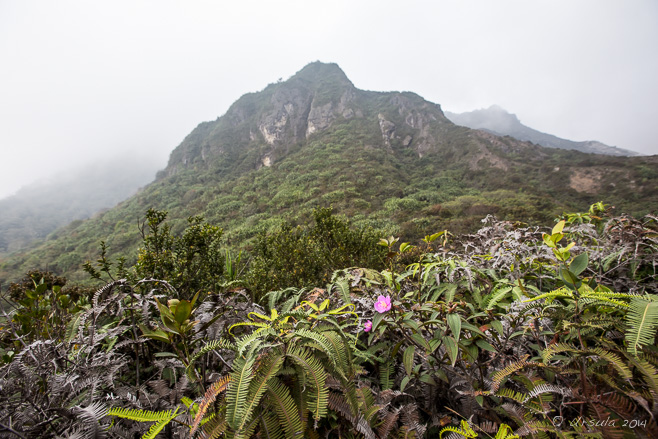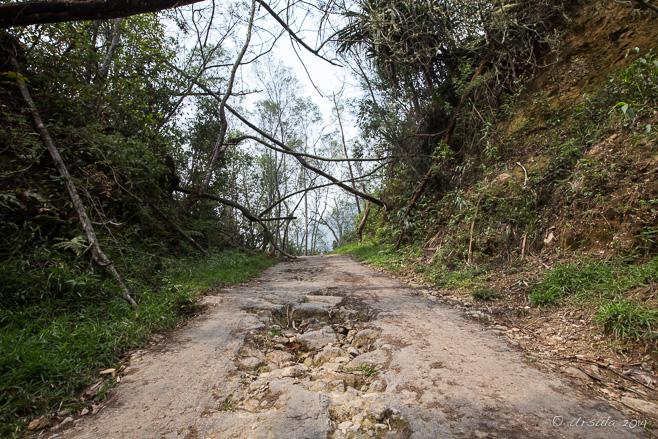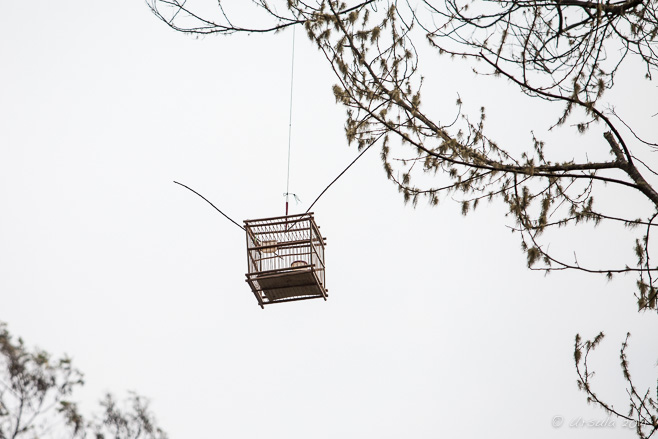
Indian Rhododendron on the Sumatran Mountainside
Overlooking the town of Berastagi in Northern Sumatra, Mount Sibayak – a small volcano – is a popular tourist attraction.
Just two weeks before my husband and I visited the island of Sumatra in February 2014, Gunung Sinabung erupted, killing at least 14 people. The province of North Sumatra is not that big: Mount Sinabung is in the Karo Plateau, only 40 kilometres away from the Lake Toba Supervolcano, and in the general region where we would be travelling. When we arrived at Bukit Lawang, about 50 kilometres north of the mountain, volcanic ash still hung thick in the air, like smoke.
Part of our our itinerary was Mount Sibayak, an inactive (but not extinct) volcano a mere 30 kilometre drive away from the scene of the Sinabung explosion. It is always hard to know, as an “outsider”, whether a visit to a region will do more harm than good when there are problems, but the guides assured us we’d be well away from areas of risk.
Still, it reminded me of a drive we had made, years ago, through flooded and washed-away villages just a day or two after unseasonable rains in East Java, en route to another Indonesian volcano: Mount Bromo. On that occasion, we stopped overnight in Cemoro Lawang, got up around 3am to have a cup of coffee before crossing the cold, dark plains at the base of the mountain on small ponies, and then scaled a rickety stairway up the flank of the cone in the bone-chilling dark of a January morning. I am usually a bit of a mountain goat, but I remember feeling anxious about falling as we carefully picked our way through the crowds gathered around the slippery edge of the crater. When we looked down (never a good plan!), the ponies appeared as small as ants on the ground below, while the heat and the smell of sulphur bubbled up to meet us from the inside vent – alluding to the hellish death that would result from a fall.
Huddled in the dark, we waited for the sunrise. Unfortunately for us, because of the overcast weather, daylight arrived murky and diffused. It was rather anticlimactic; we climbed cautiously down the stairs and pathway, tired, cold and hungry, and without the benefit of the promised display. Two years later, Mount Bromo exploded, killing two.
We were assured, however, that our climb up Gunung Sibayak would be far less eventful. After all, it is the easiest and most accessible of Sumatra’s volcanoes, taking less than two hours to walk up.

Start Walking!
Although this is still technically a roadway, it gets pretty rough and doesn’t go much further. The rest of the way is by foot.

Dangerous Birdsong
High over our heads on the steep path, a bird tied in a cage sang a sad song. The cage owner hoped this would attract other birds, who would then be captured and sold.

Cliffs and Climbing
Before long, we left the last vestiges of roadway behind and clambered up a rocky crevice: not an easy feat when you are laden with camera gear!

Path through the Jungle
At times, the path – and our guide with it – practically disappeared into the jungle growth.

Guide on the Path
He kept his eyes on the surrounds as we climbed up the flank of the mountain.

Indian Rhododendron
Back in the open, the mountainside is covered in hardy flowering bushes, like the “Pride of India” (Melastoma melabathricum) …

Pitcher Plant
… interspersed with delicate-looking but carnivorous Pitcher Plants (Nepenthes).

Coming Around the Mountain
Our guide was continually on the lookout for plants we might find interesting.

Smoke in the Saddle
As you come around the hill, the broken sides of the caldera come into view, and the smell of sulphur is stronger.

Smoke on the Mountain
Steam rises from the vents; Mount Sibayak hasn’t erupted for more than a century, but it still gives rise to plenty of geothermal activity.

Sulphur on the Rocks
The vents produce crystalline sulfur, which clings to the rocks and was once mined on a small scale.

Guide on the Rocks
Our guide climbed over the sulphur-crusted rocks, looking for a good vent…

Burning Sulphur
… to set a light to. Burning sulfur melts to a blood-red viscous liquid and runs over the rocks.

Graffiti in the Caldera
Visitors have taken the time to sculpt designs and patterns on the volcano.

Caldera in the Mist
The mountain rises up into the mists of sulphuric steam.

Cairns and Gardens
Ferns and mosses take hold in gardens sculpted by visitors.

Ferns on the Wall

Flowers and Berries
On the way back down the track, we notice different bushes.

Yellow Flowers
Not all of the plants are “pretty”, but they all have their niche.

Thermal Pipes
Driving to one of the many hot-spring bathing pools in the Berastagi area for a well-earned soak, we passed pipes boiling over with steam that was heading to the local power station.
There is nothing quite like soaking in a pool of mineral-laden hot-spring waters that have been piped in from the mountain you have just hiked!

Not particularly “eventful”, but interesting, and well worth the effort.
Happy Travels!
Photos: 17February2014























.png)


Hi Ursula. Thanks for sharing your experience hiking up to Mt. Sibayak. I’m planning a trip there soon and am wondering how to find a guide. Wasn’t able to find any online. Appreciate if you can give advice on how to find a reliable guide and if there’s any place in particular to stay at.
Thanks in advance!
Rgds,
Tiara
Hi Tiara,
I arranged our Sumatra trip through Adventure Indonesia and they took care of all the local guides. You might like to contact them.
There are a couple of big hotels and lots of small ones in Berastagi, and accommodation should be easy to find in any price range.
Cheers,
Ursula
ya please call/chat +6285270901937 for hike sibayak.